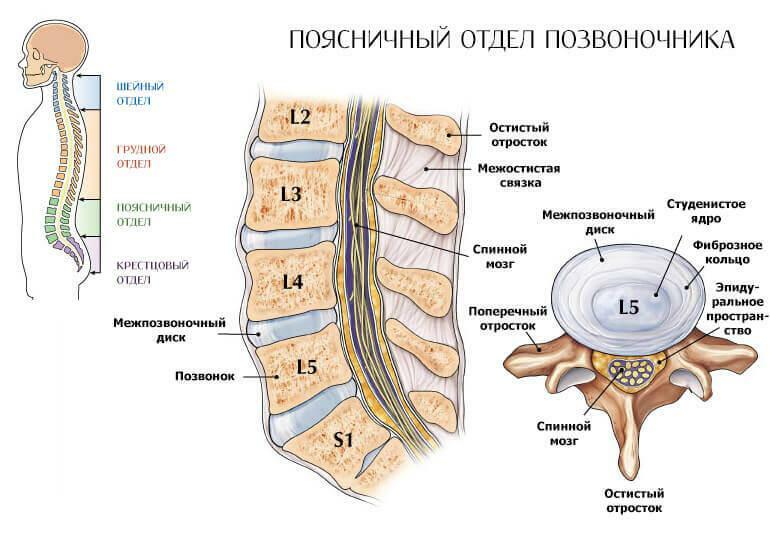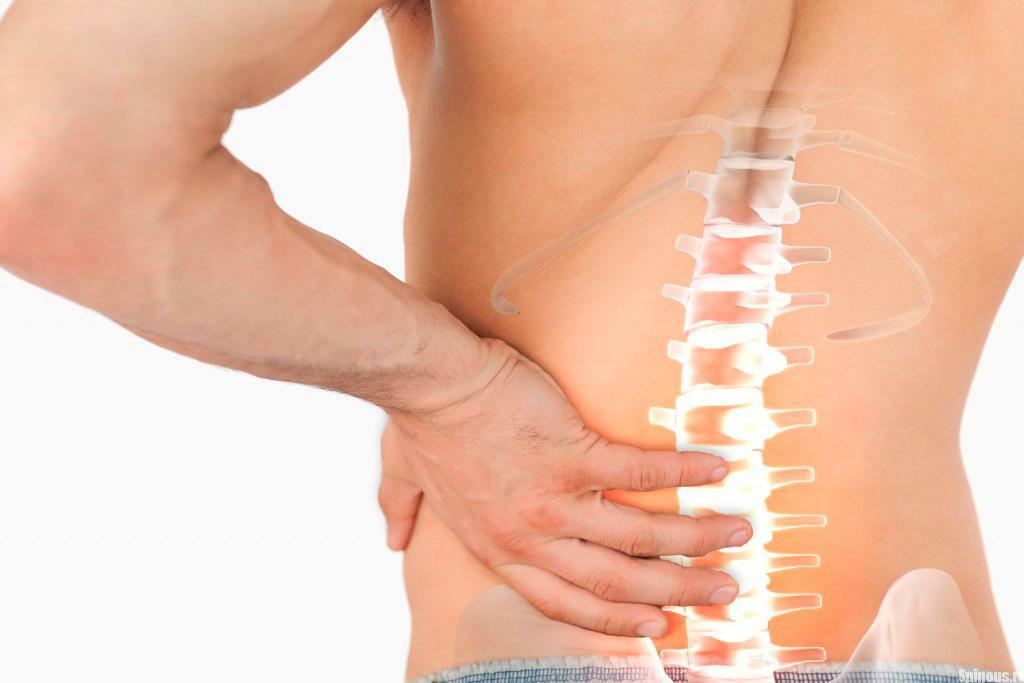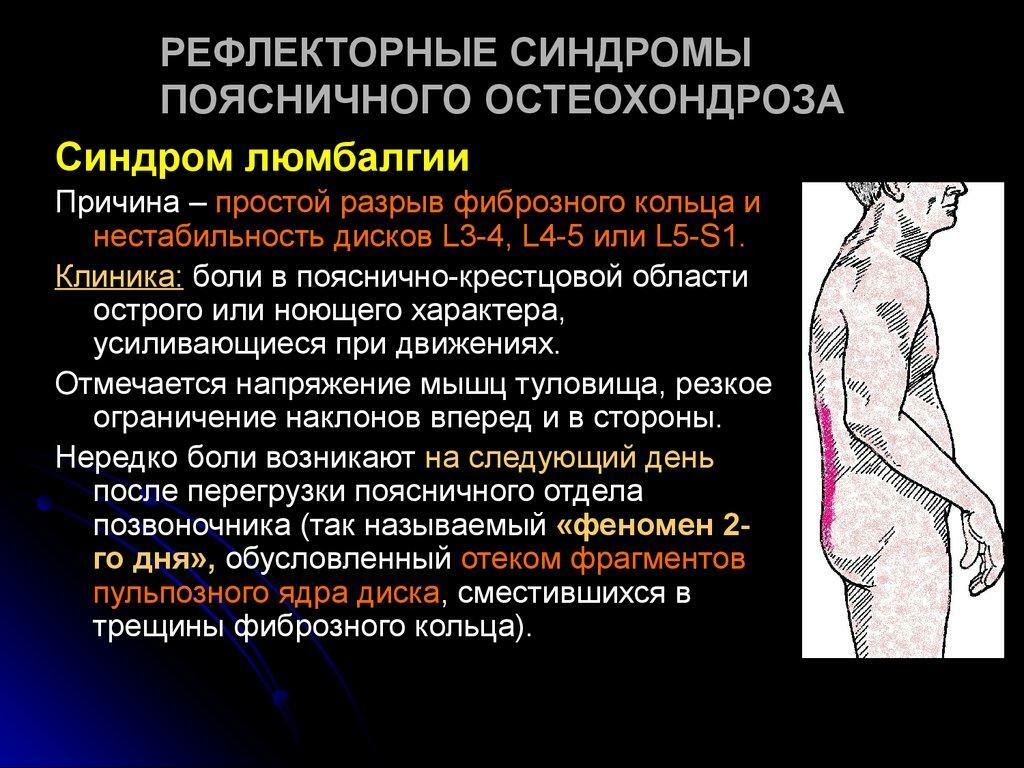Osteochondrosis in the lumbosacral region is diagnosed more often than the osteochondrosis of the cervical and thoracic areas. According to statistics, doctors put such a diagnosis in 80 percent of cases of complaints of pain in the lower back.
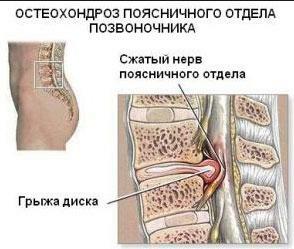
Osteochondrosis of the lumbosacral spine: treatment, injections
Content of the material
- 1 Characteristics of the disease
- 2 Symptoms of lumbosacral spine
- 3 Degrees of development of osteochondrosis
- 4 Diagnosis and treatment
- 4.1 Video - Lumbosacral spine. Diagnosis
- 5 Treatment of osteoarthritis injections
- 6 Blockade in the treatment of degenerative disc disease
- 7 consequences of degenerative disc disease of the lumbar-sacral type
- 7.1 Video - How to treat osteochondrosis of the lumbosacral spine
- 8 Preventing osteochondrosis
Feature
disease When osteochondrosis intervertebral discs gradually undergo degenerative changes, as a result ofwhich in the early stages of the disease lost the elasticity of the discs and narrowed the space between the vertebrae. In neglected cases - with osteochondrosis of 3rd and 4th degree - intervertebral disks harden, losing amortization capabilities, and exert pressure on the nerve roots. This leads to a chronic pain syndrome in the lumbar region.
The reasons for the development of lumbosacral spine include:
- Increased strain on the spine. The lumbar region, located at the base of the spine, is the highest load associated with body weight.
- Overweight, which increases pressure on the lumbosacral department.
- Insufficient physical activity. Undeveloped muscular corset, delayed blood flow in the lumbar region and disturbed metabolism favor degenerative-dystrophic destruction of intervertebral discs.
- Genetic features of the body, manifested in poorly developed musculoskeletal structure, which contributes to an increased risk of deformation of the intervertebral discs.
- Injuries due to excessive physical exertion.
- Bent posture, which contributes to an incorrect distribution of weight on the spine. Intervertebral discs deform and prematurely wear out.
- Age changes, consisting in the deterioration of the spinal elements.
- Some diseases of the spine, including arthritis, scoliosis and other diseases that contribute to inflammation in the vertebral joints.
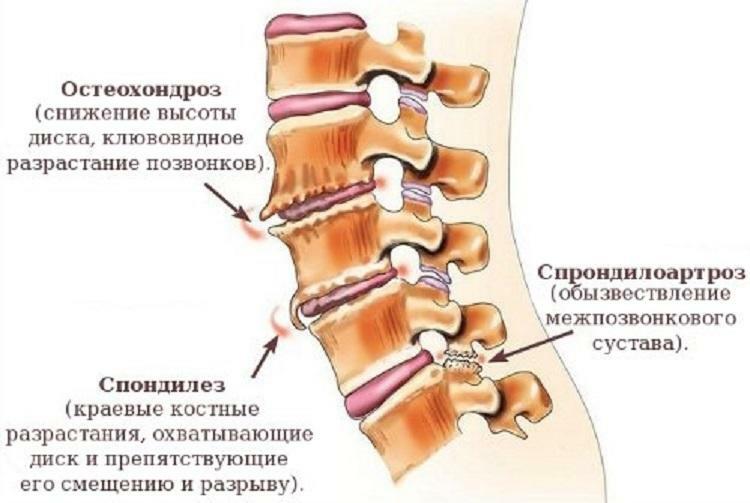
What is osteochondrosis
Sometimes, osteochondrosis can be triggered by hypothermia, poor ecology, malnutrition, etc.
Symptoms of lumbosacral spine
Symptoms of lumbosacral spine include:
- Limited motor activity. Due to deformation of the intervertebral discs, any movements that increase the load on the lower back cause pain in the back, which can spread to the legs.
- Pain in the lower back. At the first stage, slight pain can occur with certain physical exertion. With the development of the disease, the pain sensations become permanent and intensify during exacerbations.
- Loss of leg sensitivity. Nerve roots, which are in case of osteochondrosis under excessive pressure, are damaged, which leads to a change( decrease or increase) in the sensitivity of the legs. Loss of sensitivity can be accompanied by burning, numbness, creeping and tingling. With the development of osteochondrosis in the lumbar-sacral region, the muscular weakness of the lower limbs increases.
- Pale skin, increased sweating, impaired functioning of the genitourinary system.
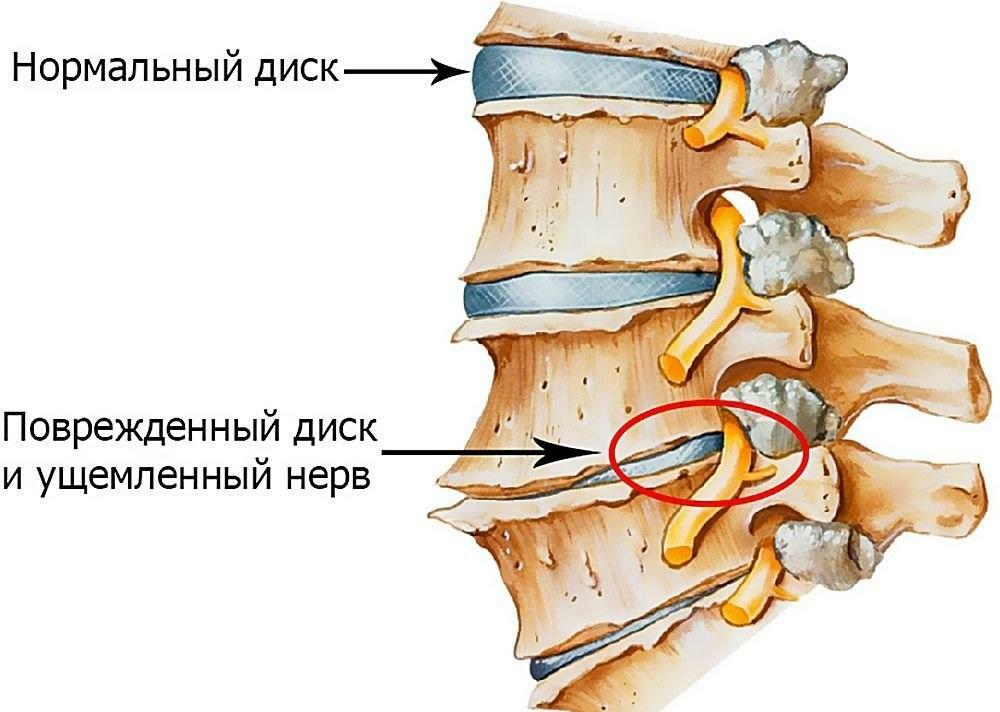
Intervertebral disc with osteochondrosis of the lumbosacral spine
Degrees of development of osteochondrosis
Table 1. Degrees of development of osteochondrosis
| First degree | Second degree | Third degree | Fourth degree | |
|---|---|---|---|---|
| Manifestations of | 1. Weak pain in the lower back, intensifying with sports. 2. Pain sensations can be accompanied by tingling and burning in the back of | 1. Sharp pain in the lumbar region can spread when walking to the lower extremities. 2. A burning sensation is added to the burning in the area of damaged vertebral elements | Intensive chronic pain, regardless of the level of locomotor activity | 1. There are problems with movement. 2. Pain sensations decrease compared to the previous stage due to growth of the musculoskeletal tissue. 3. Loss of mobility and flexibility of the waist |
| Course of the disease | Beginning of deformation processes in intervertebral disks | 1. Narrowing of the space between the vertebrae. 2. Pressure on the nerve roots. 3. The onset of destruction of fibrous rings and adjacent musculoskeletal tissue. 4. Intervertebral discs change their position relative to the vertebrae of | 1. Complete destruction of fibrous rings. 2. Intervertebral hernia formation. 3. Degenerative changes in the tissues of the spine | 1. Atrophy of cartilage. 2. Sprouting of the vertebrae. 3. Disability |
Any stage of development of osteochondrosis of the lumbosacral type can be accompanied by exacerbations.

Visual illustration of the degree of development of osteochondrosis
Aggravation of the disease can be caused by:
- Excessive emotional stress.
- Subcooling.
- An awkward movement in sports activities.
- Long-term stays in the wrong sitting posture with a hunched posture.
Exacerbation is accompanied by acute painful sensations, provoking muscle spasm in the lumbosacral section. In this case, the patient is forced to fix in a certain position.
Warning! During an exacerbation of an osteochondrosis of the lumbosacral department, any movement can cause a build-up of pain and its spreading to the lower limbs.
An exacerbation can torment the patient for several weeks. With a decrease in the pain syndrome, the muscles relax, and the ability for motor activity returns.
Diagnostics and treatment
In the diagnosis of osteochondrosis of the lumbosacral department the following measures are taken:
- Inspection and palpation of the lumbar spine.
- The patient's posture is checked.
- Radiography is carried out and, if necessary, computed tomography and MRI.
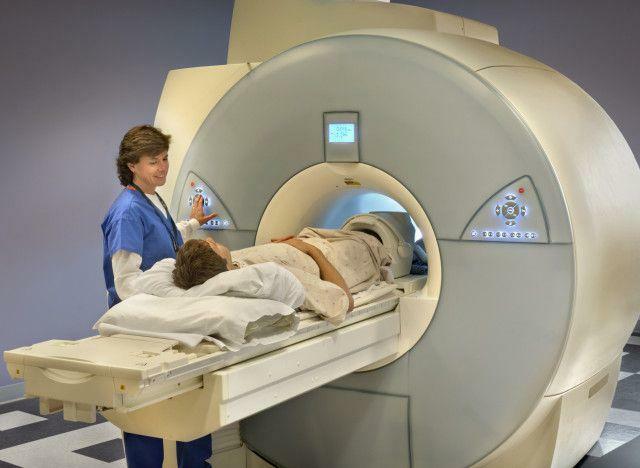
MRI of the spine
Important! Unfortunately, you can not cure osteochondrosis. But if you start treatment in the early stages of the disease, you can significantly improve the patient's well-being.
Complex treatment of osteochondrosis is directed to:
- Reduction of pain in the lower back.
- Relieving a patient from muscle spasm.
- Strengthening the muscular corset of the back and lower limbs.
- Normalization of blood flow in the damaged area.
- Removal of inflammation.
- Increased motor activity of the spine and normalization of the sensitivity of the legs.
Video - The lumbosacral spine. Diagnosis
Treatment of osteochondrosis with pricks
Important! When exacerbating osteochondrosis of the lumbosacral type, the problem arises of promptly eliminating intolerable pain sensations. In such cases, tablets, ointments or gels do not work out of time and are not strong enough, so specialists resort to anesthetic injections.
The use of nyxes for the treatment of osteochondrosis has the following advantages:
- Rapid removal of painful symptoms. When injections, the substances immediately appear in the blood and much faster than taking pills or using gels and ointments, reach the nerves. Before the active substances from the tablets enter the blood, the tablet must enter the stomach and dissolve in it, and then reach the bloodstream through the digestive tract. When injections, the speed of action increases significantly.
- Accuracy of dosage. While some of the active substances in tablets are destroyed by digestive enzymes, the drug injected through the injection reaches the target completely.
- No side effects due to direct effect on the damaged area. Blockade of the damaged area by an anesthetic injection is made under the skin at the site of painful sensations increase. Due to the point application, the drug does not affect other organs, because it acts directly on the damaged area.
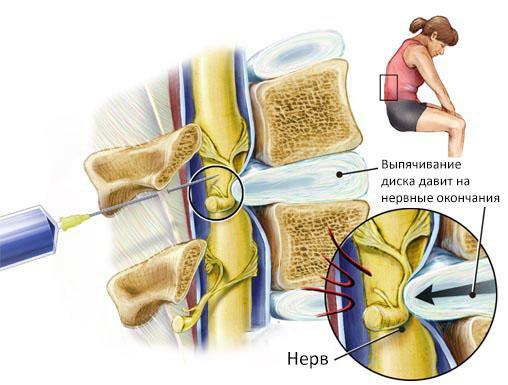
Injection of the spine block
There are the following types of injections for the treatment of lumbosacral spine:
- intravenous;
- intramuscular;
- subcutaneous;
- blockade.
The medicines used to treat osteochondrosis through injection include:
- Analgesics. Injections of analgesics have a one-way effect. Such injections eliminate pain, but do not affect the deformation processes in the intervertebral discs, so they are prescribed only with an intense pain syndrome, when there is no possibility of using another drug. To frequently used analgesics is Analgin .
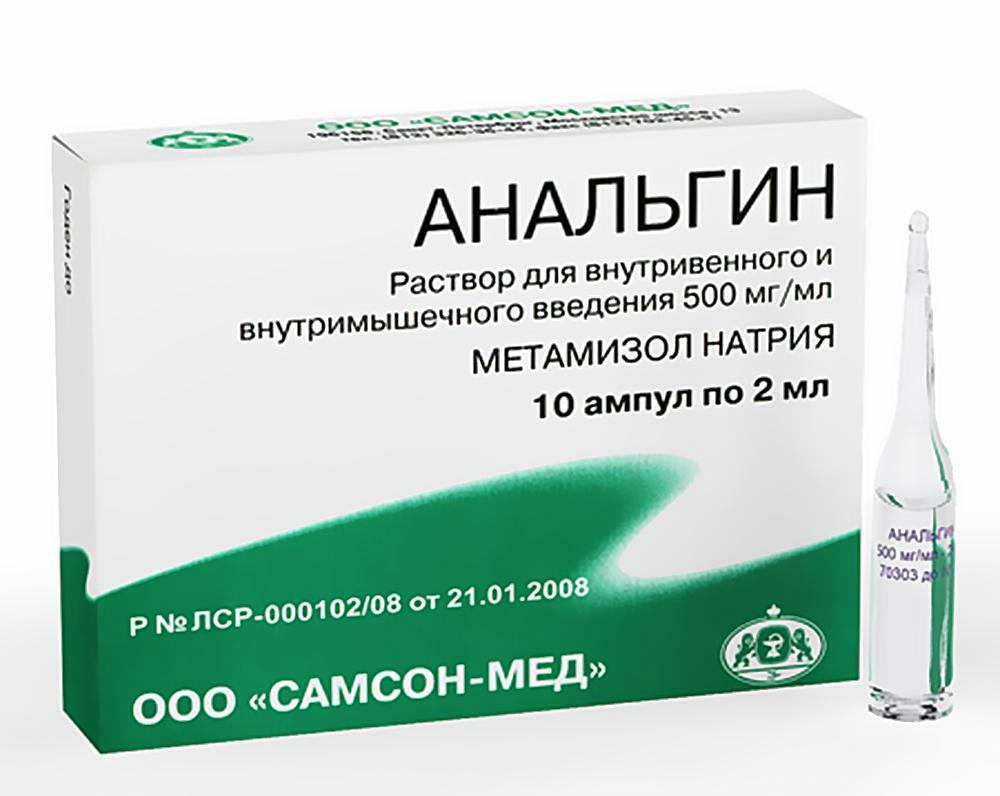
Analgin for pain relief in osteochondrosis
- Anti-inflammatory drugs of non-steroid type. Among such drugs, in the treatment of lumbosacral spondylosis, Ketonal , ibuprofen , Diclofenac sodium , and Ketorolac are most often used. Such injections relieve inflammation and pain, and also eliminate swelling. In addition, non-steroidal anti-inflammatory drugs eliminate pressure on the nerve roots by damaged tissues. This effect persists up to six months with the passage of a whole course of injections. And the inflammation can be eliminated completely.
- Mythropic antispasmodics. They are used to relieve muscle spasms in the affected area, which significantly reduces pain in the lower back. Myotropic antispasmodic drugs block the receptors of damaged muscle tissue for a certain time, thereby transferring impulses from the affected areas to the spinal cord. While the receptors are blocked, muscle tissue has time to recover. Among the myotropic antispasmodics, is allocated to Mydocalm .Its dose is 1 ml. The injections are done twice a day.
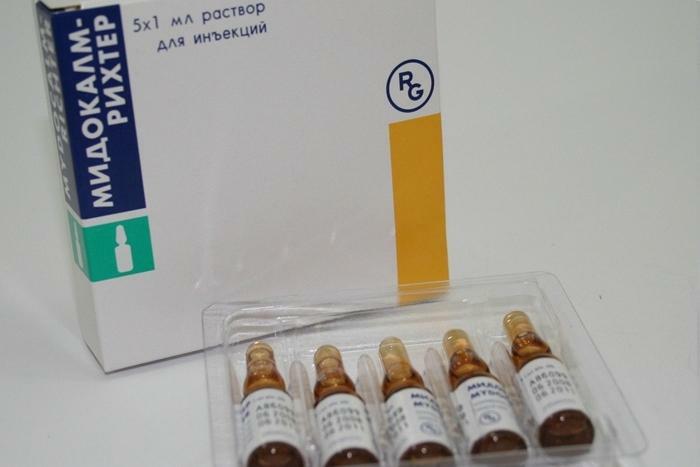
Medokalm preparation
- Steroid hormonal agents. Among the glucocorticosteroids, the drug Ambene is isolated. It consists of six ampoules, three of which contain solution A. Three other ampoules contain solution B. Due to the combined effects of solutions A and B, Ambien removes inflammation and starts the process of recovery of nerve cells. Due to the content of lidocaine intramuscular injections of steroid hormones pass without painful effects. Prick Ambene is done once a day three times a week. The next course of injections of steroid hormones can be carried out not earlier than a month after the completion of the latter.
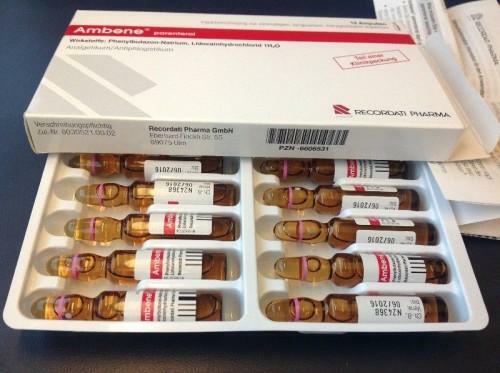
Steroid hormone agent Ambene
Blockades in the treatment of osteochondrosis
Popular types of injections for the treatment of osteochondrosis of the lumbosacral type are blockades.
Interesting! In blockades, injections have a point-like character - the injection is made directly into the damaged area.
The effect of blockade is felt right after the injection:
- stops the irradiation of pain;
- eliminates muscle spasm, inflammation, swelling and pain;
- improves blood flow in the affected area.
When blockades are used, analgesics, steroid hormones, non-steroidal preparations, and myotropic antispasmodics can be used.
Blockades can be:
- Paravertebral. The injections with different depth of injection are made in certain places next to the spine.
- Epidural. In this case, the injection is made into the epidural space of the spine.
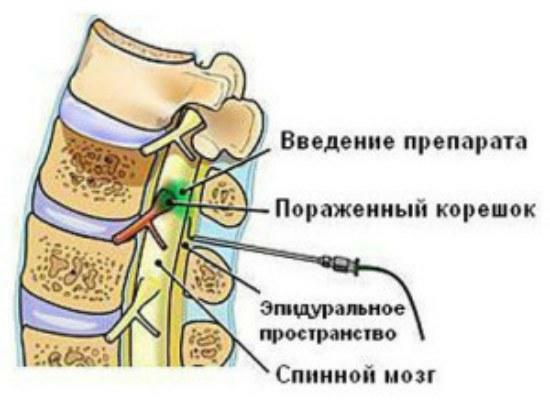
Epidural blockade of
Blockades can not be used if the patient has allergies to pain medications, as well as a significant deformation of the spine.
Consequences of lumbosacral spine
In advanced cases, osteochondrosis of the lumbosacral type leads to sciatica or sciatica, which is accompanied by severe pain in the lower back and lower limbs. Subsequently, there is a possibility of numbness in the legs.
Among the most painful consequences of a lumbar osteochondrosis, the instability of the vertebrae is isolated. Because of significant damage, the intervertebral disc can not hold the lumbar vertebrae, and they move from the sacrum.
Caution! In advanced cases, osteochondrosis leads to deformation of the spine and abnormalities in the work of internal organs.
Video - How to treat osteochondrosis of the lumbosacral spine
Prevention of osteochondrosis
For prevention of osteochondrosis should:
- Avoid increased stress on the lower back.
- To increase the tone of the muscular corset.
- Keep your posture.
- Maintain an active lifestyle.
- Properly eat.
- Observe sleep and rest.
- Treat related back problems.

